This article may contain affiliate links, from which I receive a small commission as an Amazon Associate.
This bright and fresh pesto comes together in 10 minutes and combines sweet and savory basil with nuts, Parmigiano Reggiano, and olive oil. To add a kick of flavor to your favorite meals, you can add it to pasta, sandwiches, or proteins. Traditional pesto sauce is made in a mortar and pestle; however, I make my version in a food processor. That’s what makes this recipe come together so quickly!
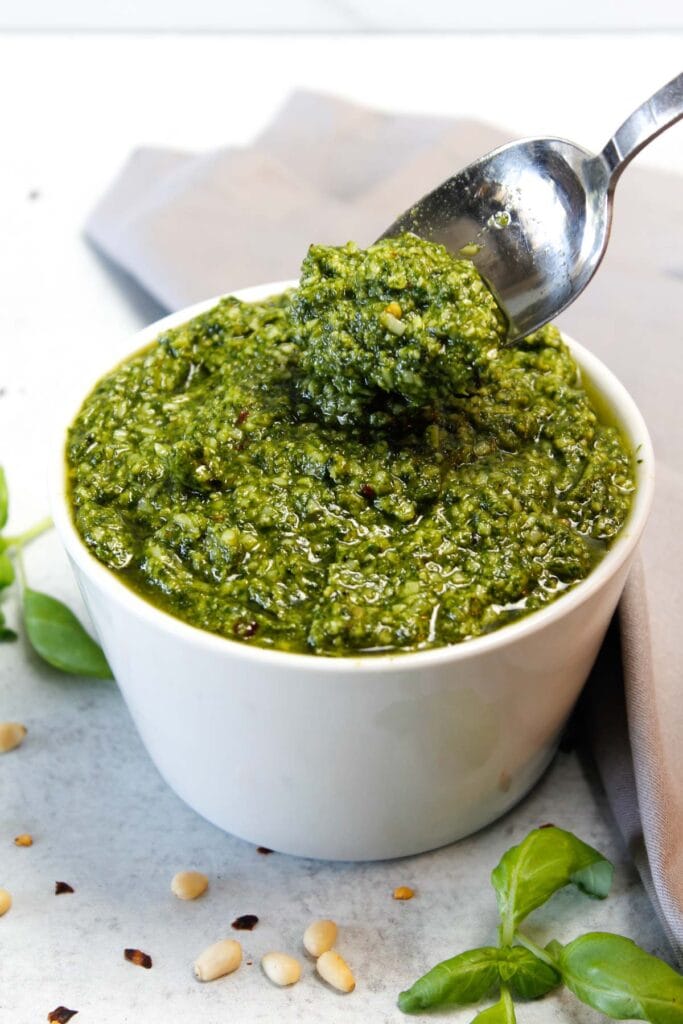
Table of Contents
Pesto definitely takes a top-five spot in my list of favorite sauces. I discovered that I was a pesto lover when I was in culinary school during an Italian course. We made a beautiful pesto Genovese pasta, and once I saw how easy it was to make, I started doing it at home.
Then Dunkin Donuts dropped the most glorious sandwich in their history, the Tomato Pesto Grilled Cheese (which is no longer sold in-store, an outrageous reality), and I was hooked! I made this sauce once a week just so I could make those sandwiches myself. On my little pesto kick, I’ve tried an array of recipes, and the one I’m sharing with you today is my favorite version with the best flavor.
Pesto Ingredients Breakdown
Every pesto has a solid and short list of ingredients, which highlights the quality of those ingredients a little more.
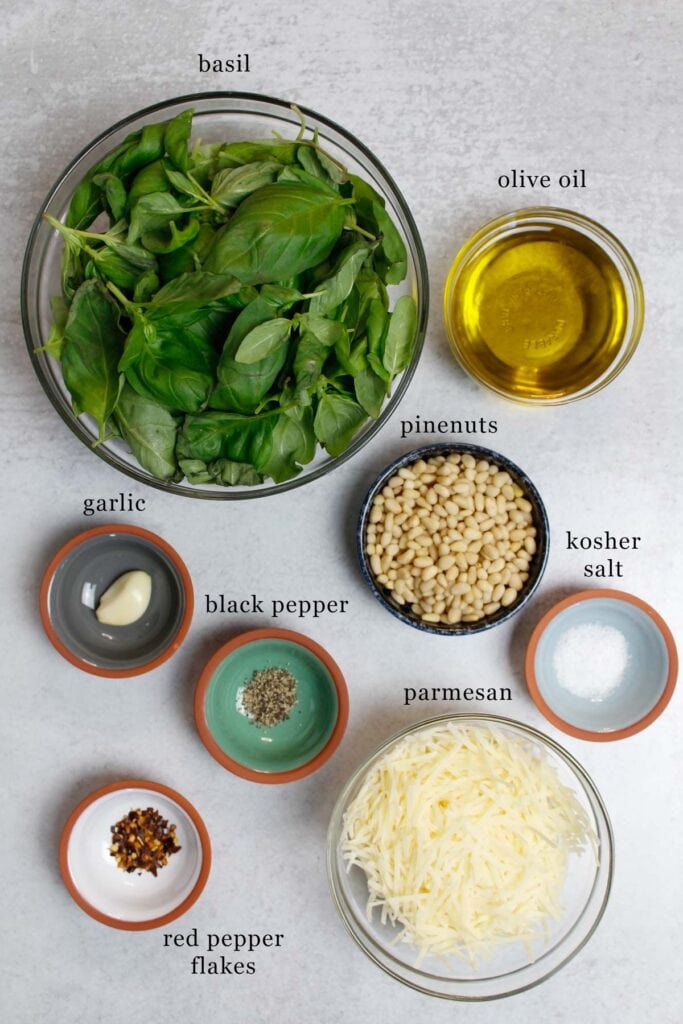
- Basil—Since this is an uncooked sauce, fresh herbs, and high-quality ingredients are important. Basil is the main ingredient in pesto sauce. Some people like to blanch their basil in boiling water and quickly shock it in ice to preserve the bright green color, but I don’t find it necessary.
- Garlic—fresh garlic cloves are key! Try to stay away from the jarred stuff. It is usually more expensive than buying a whole head of garlic and tastes dramatically different. I would describe it as acrid. You only need one clove of garlic for this recipe since raw garlic can be pretty intense, and the sauce won’t be cooked.
- Pine Nuts—Pine nuts are found in most traditional recipes, but they can be pricey. You can substitute with nuts such as cashews and walnuts to cut the cost and still end up with an amazing-tasting pesto. Whichever nut you choose to use, be sure to toast them! It may seem like an extra step, but the nutty flavor that is released when toasting makes it all worth it.
- Parmigiano Reggiano—Parmesan cheese, as well as any other hard cheese, is also okay here! The difference between the two is the aging process (Parmigiano has to be aged for at least 12 months and come from cows on special diets to be classified as such). It is more expensive, but it has a sharper and nuttier taste. Again, if parmesan is all you have on hand, use it!
- Extra-Virgin Olive Oil—This sauce won’t be cooked, so now is the time to use up your quality extra virgin olive oil! The taste will stand out more and contribute to a pleasant eating experience.
Make sure to check the recipe card for a complete list of ingredients and quantities.
Step-By-Step Instructions
Step One:
Toast your pine nuts in a small dry skillet over medium-low heat. Make sure to move the pan around until the nuts start releasing their oils, turning golden brown (but not burnt) and omitting a nutty aroma, about 4-5 minutes. Set it to the side for a few minutes to cool it to room temperature.
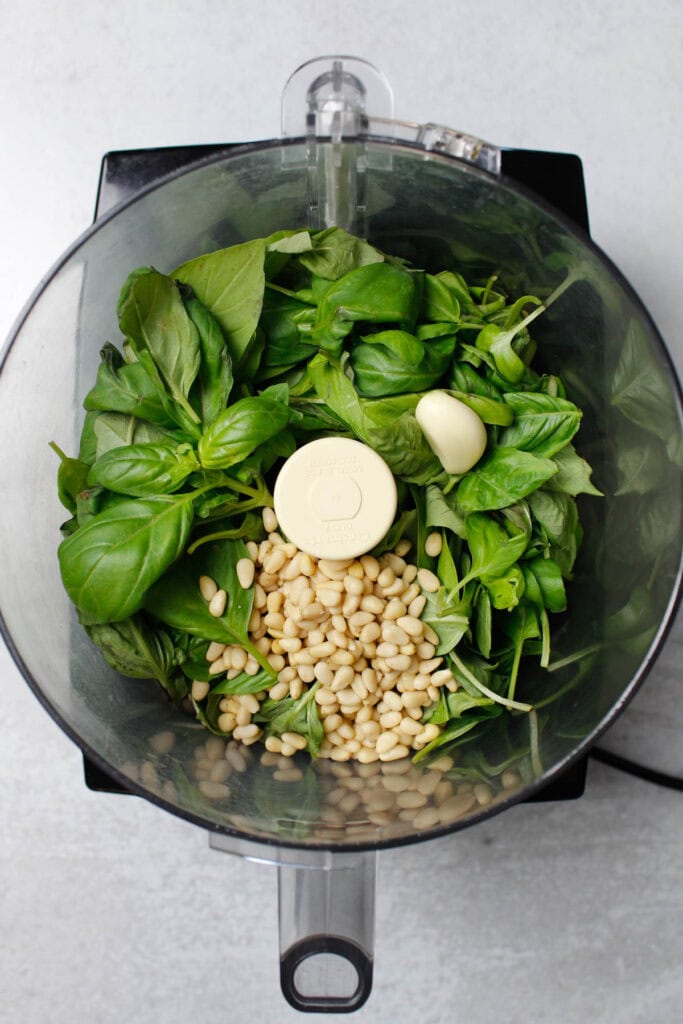
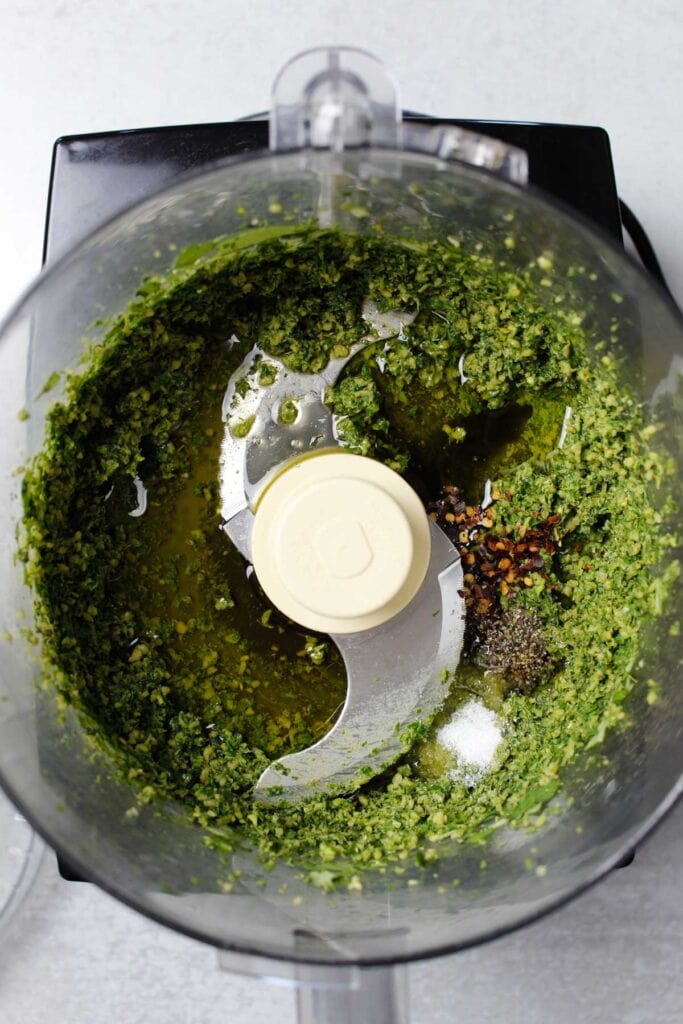
Step Two:
In the bowl of a food processor, add fresh basil leaves, a clove of garlic, and pine nuts. Pulse the mixture and pour in a steady stream of extra virgin olive oil.
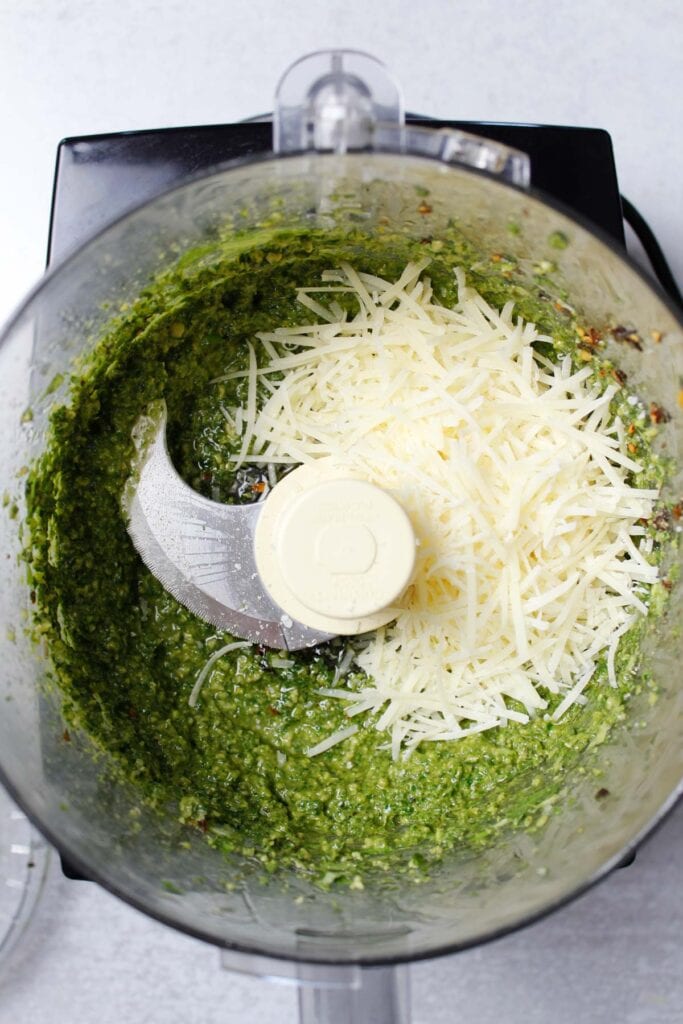
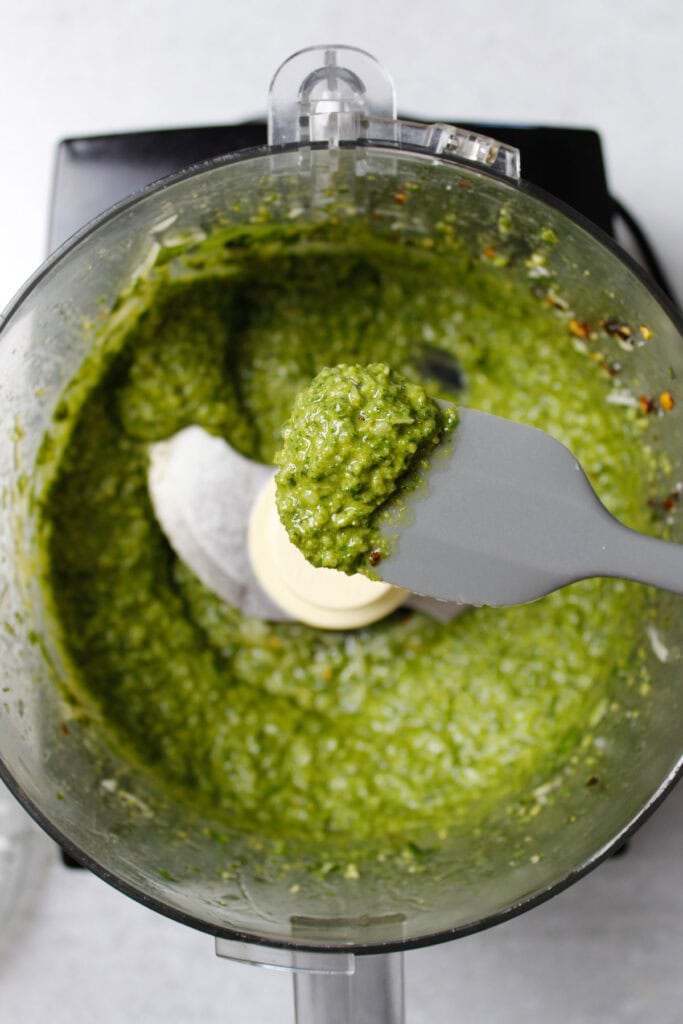
Step Three:
Add in the Parmigiano Reggiano (or whatever cheese you are using), kosher salt, black pepper, and red pepper flakes. Pulse a few more times and taste to see if you need to add more seasoning.
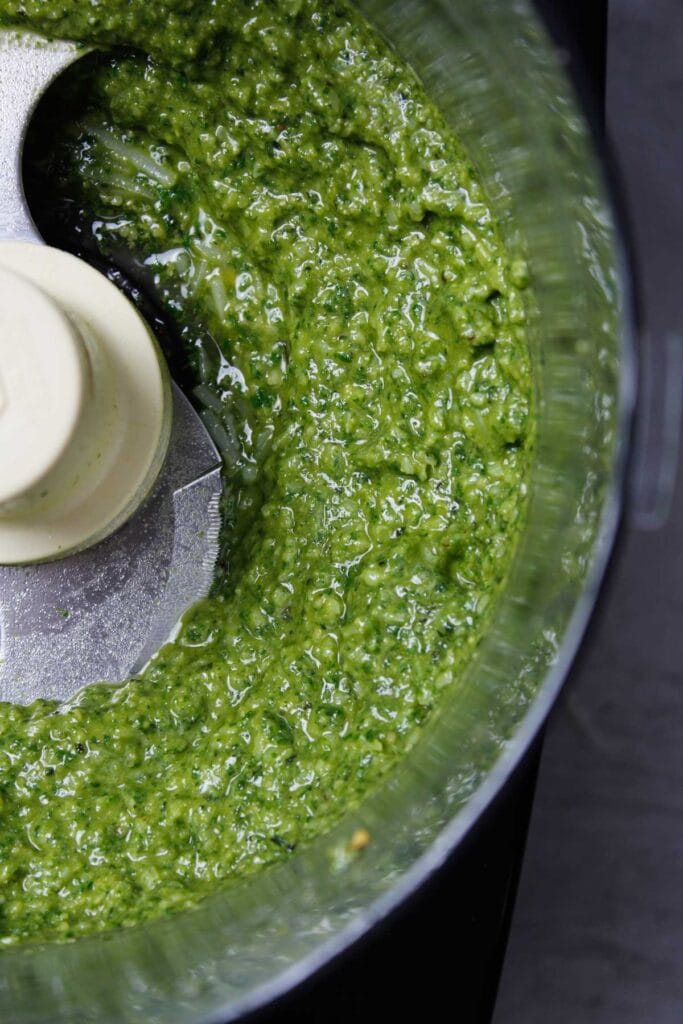
Ingredient Substitutes For Pesto
You have a few options here when it comes to choosing ingredients. Pecorino Romano can be used in place of parmesan. You can also swap out nuts if you dislike pine nuts or want to cut costs since they can be pretty expensive. I’ve made this pesto with walnuts and cashews, and both iterations came out great! If you want to make this dish dairy-free, you can substitute nutritional yeast for the parmesan cheese.
Frequently asked questions
Should pesto be cooked?
Pesto should never be cooked. It is a raw sauce, and to maintain its bright green color and fresh taste from the basil, it should be added to pasta or any other dishes at the very last minute.
What is a good substitute for pine nuts in pesto?
Pine nuts can be pretty pricey and sometimes hard to source, so you can substitute almost any other nut for them. Cashews, walnuts, and sunflower seeds are excellent substitutes for pine nuts. Just treat them like you would pine nuts and toast them before processing.
How do you keep pesto bright green?
To preserve the green color while storing, pour a thin layer of olive oil on top of the pesto before storing it in an airtight container.
What dishes can you use pesto in?
Pesto is a very versatile sauce. You can use it in various ways. My favorite ways are on sandwiches, spooned over proteins like chicken, and in pasta dishes, such as my pesto caprese pasta salad and traditional pesto alla Genovese. You can even spread it over crusty bread to serve it as an appetizer.
How do you store pesto?
You can store pesto in an airtight container in the refrigerator for up to 3 days. You can also make big batches and freeze them in ice cube trays for later use. Store the frozen cubes in an airtight freezer bag, and they’ll last for up to 3 months. I use this same method when making large batches of Sofrito, which works like a charm.
More Recipes You’ll Love!
Print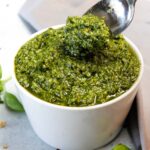
Homemade Basil Pesto Recipe With Pine Nuts
Description
This bright and fresh pesto comes together in 10 minutes and combines sweet and savory basil with nuts, Parmigiano Reggiano, and olive oil. To add a kick of flavor to your favorite meals, you can add it to pasta, sandwiches, or proteins.
Ingredients
2 cups basil leaves
1/4 cup pine nuts
1 garlic clove
1/2 cup extra-virgin olive oil
1/2 cup Parmigiano Reggiano (or parmesan cheese), grated
1/2 teaspoon kosher salt
1/4 teaspoon ground black pepper
1/4 teaspoon red pepper flakes
Instructions
- Toast your pine nuts in a small dry skillet over medium-low heat. Make sure to move the pan around until the nuts start releasing their oils, turning golden brown (but not burnt) and omitting a nutty aroma, about 4-5 minutes. Set it to the side for a few minutes to cool it to room temperature.
- In the bowl of a food processor, add fresh basil leaves, a clove of garlic, and pine nuts. Pulse the mixture and pour in a steady stream of extra virgin olive oil.
- Add in the Parmigiano Reggiano (or whatever cheese you are using), kosher salt, black pepper, and red pepper flakes. Pulse a few more times and taste to see if you need to add more seasoning.

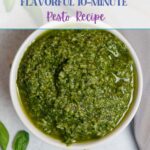
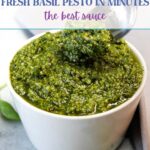
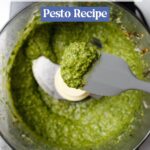
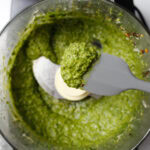
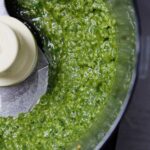
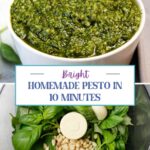
I tried this pesto recipe last night, and it’s now my go-to! I used walnuts instead of pine nuts, and it still turned out amazing. The tip about adding a thin layer of olive oil on top for storage worked perfectly. This pesto is going to be a staple in my kitchen!
Thank you so much for trying this recipe & leaving a review, David!! I am glad that you enjoyed it & that the storage tip worked for you 🤗
Just what I was looking for. Thank you.